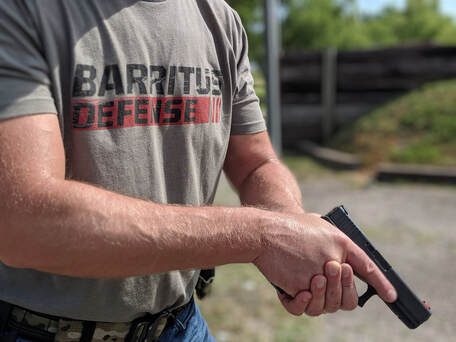|
If you carry a firearm for your protection, you understand the importance of being prepared for any situation. If you're like me, you don't get out to the range nearly as much as you'd like. However, the reality is that live-fire training is not where you spend the majority of your time building your skills. That's right. Ask any competitive shooter or shooting professional who is at the top of their game, and they'll tell you that you make your money during your dry-fire sessions. Most people are familiar with dry-fire training, but in case you're not, dry-fire is simply practicing your shooting skills without live ammunition. Dry-fire training has a ton benefits, including improving your accuracy, speed, and overall shooting proficiency. It also helps to reinforce proper gun handling techniques and provides an opportunity to practice weapon manipulation skills. Before we dive into some tips and tricks to maximize your dry-fire training, it is important to emphasize that safety always comes first. Always ensure that there is no live ammunition in the gun or magazine before beginning your dry-fire session. Additionally, always use a safe and secure backstop to catch any dry-fired rounds. Now, let's get to some tips and tricks to help you maximize your dry-fire training: 1. Focus and Concentration: Limit Your Training DurationOne of the most common mistakes in dry-fire training is practicing for too long without a break. For me, I like to limit my sessions to 10-20 minutes. This helps me stay super focused and concentrated on the task at hand. Before I know it, the session is over, and I'm left with the feeling of wanting more. I just cage that little tiger and keep him hungry until the next session. It keeps me motivated and excited to stay on the path.
2. Get a Proper Grip from the Draw The draw is one of the most critical aspects of your shooting technique. It's crucial that you get a proper grip on your gun as you draw it from your holster. This will help you maintain control over your weapon as you begin to string your shots together later on during your live-fire sessions. Plus, if you have to adjust your grip after you've drawn it from the holster, that will cost you time when taking your first shot. To get a proper purchase, take your shooting hand and place it as high as you can on the pistol grip. There should be a ripple in the webbing of your hand with no space between it and the beaver tail. Your support hand should wrap nicely around your knuckles of your firing hand with your wrist locked out and thumbs forward. Make sure your thumbs are indexed along the frame of the weapon and not the slide; otherwise, you can induce a malfunction. Make it automatic. 3. Drive the Gun to Your EyesAs you aim at your target, focus on the front sight and drive the gun to your eyes. This means that you should be bringing the gun up to your line of sight, rather than looking down to find your sights. Just like when you see an object and point at it with your finger, you don't go searching with your eyes for the tip of your finger. The naturally lines up to your eye. Do the same thing with your sights. Pick a small point on the target, then drive the gun to your eye. With practice, your sights will naturally come into alignment as you index towards the target. 4. Practice Weapon Manipulation Skills Weapon manipulation skills are essential for any shooter, and dry-fire training provides an excellent opportunity to practice these skills. Practice your draw and presentation, loading, reloading, and clearing malfunctions with your gun to improve your proficiency in these critical areas. That way, when you do go to the range, you can work on building the skills that can't be easily developed during dry-fire practice, like recoil management, trigger manipulation, etc.,. 5. Have a Plan: Choose Specific Skills to Work on Finally, it's important to have a plan before you begin your dry-fire training session. Instead of randomly practicing different drills, choose one or two specific skills to work on during each session. This will help you to ensure that your time is well spent and that you're making progress towards your goals. It's just like working out at the gym. When you go to the gym, you should have a set plan - whether it's leg day or push-pull splits. You typically have a plan mapped out before you you start your workout. Do the same with your dry-fire training and you'll see faster results. To wrap it up, dry-fire training is an essential component of your shooting practice, and by following these tips and tricks, you can maximize your training sessions and improve your overall proficiency with your firearm. Remember to always prioritize safety and make dry-fire training in your regular routine. What tips have you found helpful with your dry-fire practice? I'd love to hear about your experiences, so drop 'em in the comment below. Stay sharp.
0 Comments
Leave a Reply. |
Archives
November 2023
Categories |



 RSS Feed
RSS Feed